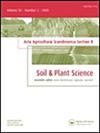砂质粉砂壤土可能会阻碍苜蓿的接种效果
IF 1.8
4区 农林科学
Q2 AGRONOMY
Acta Agriculturae Scandinavica Section B-Soil and Plant Science
Pub Date : 2023-06-01
DOI:10.1080/09064710.2023.2212674
引用次数: 0
摘要
本文章由计算机程序翻译,如有差异,请以英文原文为准。
Sandy silt loam soil may hamper the inoculation effect on lucerne (Medicago sativa L.) growth
ABSTRACT Despite newly approved lucerne cultivars, this has not led to increased use of this legume in high-latitude agriculture. Challenges with inoculation by Rhizobium meliloti have been identified as a bottleneck to adaptation. Here we tested inoculation sources (ISs) with soil types and cultivars in pot and field experiments. During a one-year outdoor pot experiment, we tested the impact of IS (wet peat slurry and Nitragin Gold dry inoculation) and three soil types (sand, sandy silt and /peat soil) on nodule development, shoot and root growth and winter survival of one hybrid lucerne cultivar (‘Ludvig’). The pot experiment revealed that dry inoculation led to significant better plant growth, flower and nodule development as well as plant regrowth after winter survival. Peat soil appeared as the best growth medium and silty soil limited inoculation efficiencies. In field trials at two locations differing in soil characteristics using similar ISs, and three hybrid lucerne cultivars (‘Lavo’, ‘Live’ and ‘Lotte’) biomass yield during two ley years showed site as well as cultivar differences. Such environmental interactions in the field trials justify the use of adapted cultivars, and dry inoculation should be recommended for practical use replacing peat slurry inoculation.
求助全文
通过发布文献求助,成功后即可免费获取论文全文。
去求助
来源期刊
CiteScore
4.40
自引率
0.00%
发文量
56
审稿时长
2.3 months
期刊介绍:
Acta Agriculturæ Scandinavica Section B publishes original research in applied soil and plant science with special attention given to to crop production in agri- and horticultural systems. We welcome manuscripts dealing with:
Climate smart and sustainable crop production systems
Water and nutrient efficiency
Soil conservation and productivity
Precise agriculture systems
Applications of bio- and nanotechnology
Digitalisation and robotics
Soil-plant interactions
Acta Agriculturæ Scandinavica, Section B – Soil & Plant Science forms part of a series of titles published on behalf of the Nordic Association of Agricultural Science (NJF). The series also includes Section A - Animal Science .

 求助内容:
求助内容: 应助结果提醒方式:
应助结果提醒方式:


